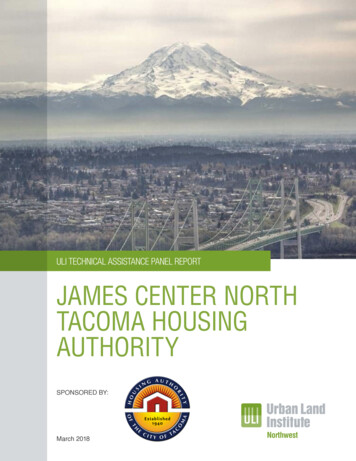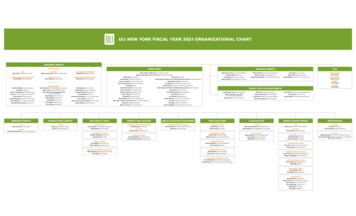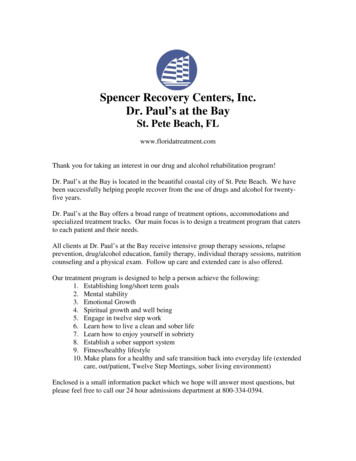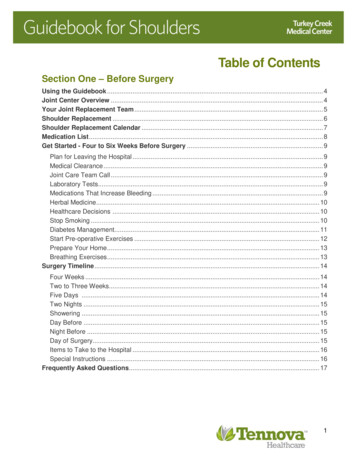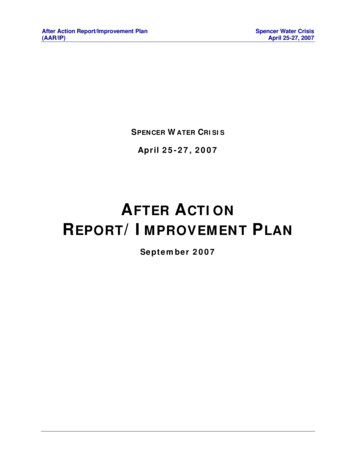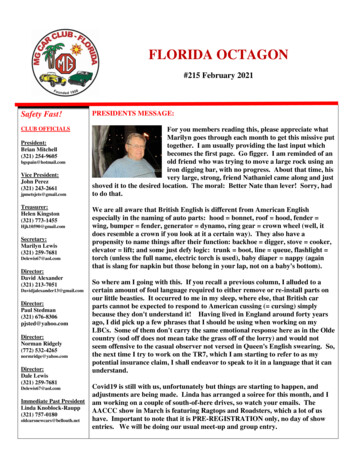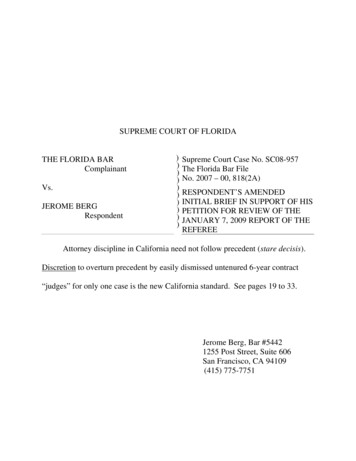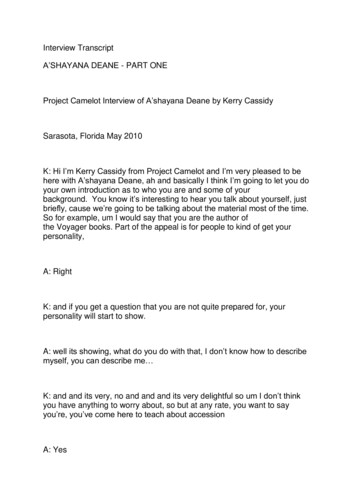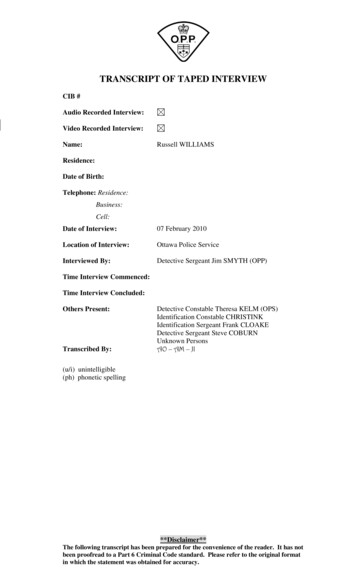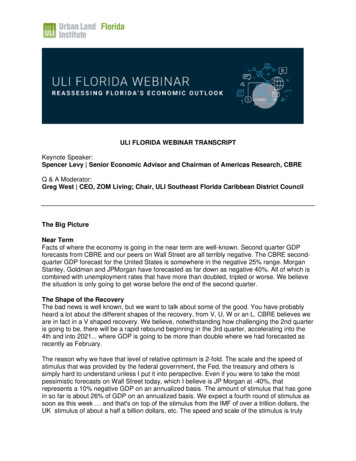
Transcription
ULI FLORIDA WEBINAR TRANSCRIPTKeynote Speaker:Spencer Levy Senior Economic Advisor and Chairman of Americas Research, CBREQ & A Moderator:Greg West CEO, ZOM Living; Chair, ULI Southeast Florida Caribbean District CouncilThe Big PictureNear TermFacts of where the economy is going in the near term are well-known. Second quarter GDPforecasts from CBRE and our peers on Wall Street are all terribly negative. The CBRE secondquarter GDP forecast for the United States is somewhere in the negative 25% range. MorganStanley, Goldman and JPMorgan have forecasted as far down as negative 40%. All of which iscombined with unemployment rates that have more than doubled, tripled or worse. We believethe situation is only going to get worse before the end of the second quarter.The Shape of the RecoveryThe bad news is well known, but we want to talk about some of the good. You have probablyheard a lot about the different shapes of the recovery, from V, U, W or an L. CBRE believes weare in fact in a V shaped recovery. We believe, notwithstanding how challenging the 2nd quarteris going to be, there will be a rapid rebound beginning in the 3rd quarter, accelerating into the4th and into 2021. where GDP is going to be more than double where we had forecasted asrecently as February.The reason why we have that level of relative optimism is 2-fold. The scale and the speed ofstimulus that was provided by the federal government, the Fed, the treasury and others issimply hard to understand unless I put it into perspective. Even if you were to take the mostpessimistic forecasts on Wall Street today, which I believe is JP Morgan at -40%, thatrepresents a 10% negative GDP on an annualized basis. The amount of stimulus that has gonein so far is about 26% of GDP on an annualized basis. We expect a fourth round of stimulus assoon as this week and that's on top of the stimulus from the IMF of over a trillion dollars, theUK stimulus of about a half a billion dollars, etc. The speed and scale of the stimulus is truly
unprecedented, and it will provide the fuel to bounce back more quickly than in any prior crisis,certainly in the last 40 years.‘Comps’ from prior crisesI'm a real estate expert and I try to find the ‘comps’ that are most important and relevant to thisconversation. The two comps that everybody here is looking at and thinking about are the postGFC 2009 and the post-”9/11 Tech Bubble” of 2000 comps. If one were to look at those twocomps alone, one would reach the conclusion that: If you look at the office segment, etc., rents took about two years to crater from peak totrough, and an additional 4 years to come back fully. Values bounced back a little quicker and took about 4 years ago to go from peak to peakagain. But that's not across the board. Industrial assets never declined in value post 9/11-TechBubble. Of course, if you go market-by-market you will see different variations on that theme.Lessons learned from AsiaWe are also looking beyond these comps to those in Asia. The most relevant or rather the mostsimilar event in recent history to the Covid-19 crisis was the SARS crisis in 2003. There wasa terrible fall off in Hong Kong in the economy, in real estate trades, in rents, etc. It lasted forabout a year before bouncing back strongly. The fall off wasn't nearly as bad in other Asiancountries. Nevertheless, the crisis lasted 6 months to a year before it started bouncing back topar again.I also point to what's happening today in China during the Covid-19 crisis. A lot of people willsay China isn't a good comp because of its different form of government, some question thevalidity of the information coming out, etc. There is no such thing as a perfect comp.China as recently as a month ago had basically all industry shutdown, every shopping centerclosed, every Starbucks closed. Today over 95% of Starbucks are open, over 95% of theshopping centers are open, industrial capacity is back to over a 90% level. We can measure thisnot only by numbers coming out of the government, but by other measures such as oil andelectrical usage all returning to normal. Some of the things that are going to return much moreslowly (and we would expect a similar pattern here in the US) include large purchases likeautomobiles, homes and travel. These purchase categories are most relevant in places likeFlorida, where travel in particular is a very important industry to several markets.The bottom line is this -- from a macro perspective we believe we will bounce back quicklybecause of the stimulus and what these comps help illustrate.Zooming into the micro-perspective and the real estate industryNotwithstanding our optimism for a “V shape” recovery on a macro level, we are not asoptimistic about as quick of a recovery in the real estate industry. If you want to understand ashape in your mind, expect more of a Nike shape (somewhere between a U and V shapedrecovery).
Real estate is always a lagging indicator for the broader economy, as it has been in every crisis,including the SARS event in Asia. Performance will vary by asset class. We track this on a dailybasis, including collections, landlord-tenant relations and other factors that can help us gaugepresent conditions and what real estate is going to look like 90, 120 days from now. In the US,CBRE manages over 7,700 daily transactions, so I watch collections everyday across the board.The good news is that office, multi-family and industrial have largely outperformed ourexpectations in terms of collections -- all tracking at or around 90%. Unfortunately, retail hasunderperformed our expectations, tracking between 20 and 40% in collections. Certaincategories, such as restaurants and others that have experiences where people have tocongregate, the collection rates are even poorer.So, what does that mean for the future?If you track the collections and the mega-trends -- industrial, then multifamily, followed by officewill bounce back quicker than retail and hotels.Hotels have the pent-up advantage of pricing power where they can always price down rates tothe point where people will bite. We think leisure travel will bounce back quicker than businesstravel. This is excellent news particularly for ULI members in Orlando and Miami, which havesuch a heavy tourist component to their economies. Business travel is going to take some timeto come back which will ultimately retard the growth of the hotel industry and keep pricing powerdown.In terms of retail, we think it will come back slower. The tragedy of retail is that there's going tobe some percentage of retailers, notably restaurants, that will never recover. Based upon a callwe had the other day with our Restaurant Group, we believe that the number of restaurants thatmay never return could approach 20%. The bad news is the terrible human story of the peoplewho lost their livelihoods; the good news is that the government understands this. In fact, thismorning Goldman Sachs became more optimistic on their economic and stock market call thanthey were as recently as a few weeks ago. This is because they know that the government isthrowing everything at this -- not only from the PPP program (which is the Payroll ProtectionProgram) but other forms of lending that we believe are not only going to help cushion the falltoday, but help push the economy moving forward.CBRE is talking a lot about how landlords are dealing with the rent crisis. In my business I'mtypically looking a year or two down the road, because my investors are 3, 5, 10-year investorholders. Now, I'm looking very closely at the next 90 to 120 days, because I want the market toreopen. The market isn't closed per say -- we are still trading hundreds of millions of dollars ofassets a week, we are doing hundreds of millions of dollars of financing every week -- and notall of these are industrial retail. In fact last week, we traded a grocery anchored shopping centerand did financing on hotels. So the market is not “closed”, but volume is down by about twothirds.A disproportionate amount of the investors that are out of the market today are institutionalinvestors, not private investors. The reason for which is two-fold: (1) a thing called thedenominator effect -- because their stock holdings have gotten so impaired, they now don't havethe percentage of their investment that can go into private real estate; (2) the bigger issue isprice discovery. I've had many investors tell me “I'd like to buy, but I don't know what rent roll I'm
buying” -- which is why rent collection analysis is so critical. We need to know when we get tothe bottom, so that we can anticipate what things will look like going forward.Today, people are dealing with rent roll and price uncertainty by employing a couple differentstrategies. The first and most common strategy is extending closing periods out 45 days orlonger. The second strategy we have seen people employ is putting in a cash flow escrowwhere they will have 6 months to up to two years of cash set aside and they will burn it downdepending what your collections are over the next couple of years. Lastly, we of course haveseen some repricing activity. So far, we have seen a lot of ‘asks’ for repricing, we haven't seen alot of ‘gives’ on repricing more often we just see deals falling away. We are aware of a selectfew deals where we saw material repricing (10% ), but it has only been in circumstances wherethe seller had a reason to sell (needed cash for another deal, etc.).What's going to happen to values in the short-term in our business?Looking to Asia again as an imperfect comp, my good friend and colleague Henry Chen in HongKong recently did a survey. He estimated that cap rates would expand in Asia by 50 to 75 basispoints in the near term, basically across the board. The exception was industrial, where he sawcap rates were largely flat.CBRE is the largest appraiser firm in commercial real estate. In speaking with our head ofvaluations, he doesn’t think cap rates will back up as much as we saw in Asia but will be closerto 25 basis points. His more optimistic view of cap rate expansion is due to the fact that the costof capital is low and likely to get lower (in the form of lower-cost debt and more equity coming infrom overseas because the US will be seen as a safe haven). Even if we have a 25-basis pointrise in cap rates (which is relatively modest), we still expect values in the short-term to fallanywhere between 10 and 20%, because fundamentals have deteriorated.There isn't a person on this webinar who believes that rents are going up in the next year ormore. They are more likely to fall. We already have objective evidence of this in the multifamilyspace -- as Costar reported this last week. Our valuation expert believes that in the other assetclasses you are at best going to see flat, but more likely lower, rents in the short-term. We hopeto see a spike in year 3. Overall, this equates to this 10 to 20% drop. Again, this is asset andmarket dependent -- some will do much better than that (core stable assets in CBDs) and somethat will perform worse (secondary assets/secondary markets).The After Effect of COVID-19: Secular vs Cyclical ShiftsHas there been a secular shift in the use of office, retail and industrial? Cyclical shifts indicatean up and down, temporary change. Secular shifts indicate this time is different and nothing isgoing to go back to the way it was before.OfficeThe office argument that I'm hearing today is that “because we are successfully working fromhome, we're going to continue working from home. We are more likely to do Zoom calls in thefuture, work outside of the office, etc.”Here is the counterargument. Up until February of this year, every survey we did of theworkplace and why people go to the office said that people are better in the office environment - ‘better’ in objective ways in terms of productivity, happiness, and attracting and retaining talent.This is not going to change.
What we may see is the rise of “fluid workplace”. I use that term specifically in contrast to theterm “the agile workplace” (i.e. what is going on within the four walls of the office. Open areasfor congregating, conference rooms for quiet space and other mixed uses within the workplace).A “fluid workplace” is people working from anywhere at any time (i.e. working from your phone,Starbucks, the back of your car/autonomous vehicle, etc). CBRE recently came out with a reportcalled The Age of Responsive Real Estate: The 2030 Report which talked about how this “fluidworkplace” trend was going to rise prior to the COVID-19 pandemic. You can still bet that westill are going to see both the rise of this trend, as well as see people go back to the office.Anecdotally, if we look at major events like Hurricane Sandy (the devastating 2011 storm that hitlower Manhattan and caused billions of dollars of property damage in the office sector) the officesector reacted by becoming more resilient. Critical infrastructure that was below the flood linewas moved above grade, owners made sure to have redundant electrical systems in theirbuildings, etc. The impact of these changes was born out in 2017’s Hurricane Harvey inHouston and in the Mexico City Earthquake, where most of the office stock was unharmedbecause the industry had already adapted to change and the risk factors of past naturaldisasters.t. They got better, they got stronger. Post COVID-19, people will return to the officefor the same fundamental reasons as before (productivity, happiness, attracting/retaining talent);however, the office sector may change in the following ways: Likely to see a less dense office space. The average square footage per employee hasgotten tighter and tighter for the last ten years. We may see the pendulum swing back aspeople desire more physical separation between one another. This could make thedemand for office space go up, not down. Upgraded HVAC and other air cleanliness systems, not dissimilar to what you might seein a medical office building. We aren’t going to see surgical level cleanliness in the officeenvironment, but we will see a cleaner environment in both the physical structure(HVAC, etc.) and through other means.In the context of the impacts on office, a lot of people are asking about the future of coworkingpost COVID-19. Notwithstanding the challenges of some of the big-name companies likeWeWork, etc., we still believe coworking has a very strong future. The next 90 or 120 days aregoing to be extraordinarily challenging, much like retail, because they have lost most of theirtenants in the short-term. However, this doesn’t negate the fact that coworking has proven tobe an effective way not only to work, but is also an effective strategy for corporate users. Wethink this will continue.IndustrialIndustrial has been the net beneficiary of just about every megatrend for the last 20 years, and itis led by ecommerce. Things are now likely to accelerate thanks to the same concept wediscussed earlier for office: resilience.We proved that we weren't resilient enough for this event when we saw supply chains getstrained in China and elsewhere when things got difficult. We need more industrial space, notonly for supply chains for domestic manufacturers, but also for things like food and cold storage(an area we have been talking about for over a year now). That being said, the world is movingquickly. I just read a report in The Economist that said despite the fact that we had huge spikes
in grocery sales in March, sales have already fallen off dramatically at the moment, due to a“bunker style” purchase sentiment. So even if we believe that cold storage and at-home deliveryof goods is the future (and that this trend might accelerate) -- it's not going to accelerate at thepace that you might have thought it would during the shopping surge 3 weeks ago. I think you'restill going to see the strongest area of retail has been and always will be the grocery anchoredsector. Another area of industrial we like, in addition to cold storage, is the ever-increasing needfor last mile.There is the other secular argument as it relates to how much manufacturing is going to comeback into the United States. This is a trend we have been talking about for five plus years. Dueto cheapening automation, we believe you're going to see more manufacturing come to highlabor cost places like the United States and Europe. We see this accelerating now because ofthe resilience argument. People are going to want to have more manufacturing here in order tocreate more secure supply chains.RetailThe last secular argument I am going to counter is in the retail segment. For the last ten yearswe have heard the narrative that bricks-and-mortar retail is dead. And now some folks aresaying they are never going back to a bar or restaurant.My colleagues in Hong Kong say today there are already lines of people outside of luxury goodsstores and restaurants, a phenomenon that is being termed “revenge retail”. There is pent updemand. We are likely to see a surge of people going back to retail places immediately after thedoors are reopened.The restaurant space is going to be constrained likely until early 2021, but it along with gyms,bars, sports games, etc. will come back just as strong as before. These are not secular shifts -they are short-term problems until the virus is under control.Austria reopened the doors this week on small shop retail space. They are likely opening thedoors next week on large shop retail space, and for restaurants in about 3 weeks. This isprobably going to be the same thing we see here in the US eventually.In the short term, retail will observe social distancing, offices will limit the number of people whocan go into an elevator and improve desk spacing within the office, we’ll wear masks andgloves, etc. But in the long-term, retail and office will be just fine. Industrial will be a net winnerhere as well.Audience Q & AYou spent some time talking about secular changes that may come out of this pandemic. Thecrisis we are having now did not come from the financial markets, this feels a bit more like 9/11,than 2008. Are there lessons learned from 9/11 that would help inform us as to how we shouldexpect the recovery to happen here?There are two answers here: the macro answer (what happened to the economy) and the microanswer (what happened to real estate). The terrible tragedy of 9/11 from a human standpointcan't be understated, but from a real estate standpoint we saw in the short-term in New YorkCity that people started paying more to be on lower floors of the building because they were
afraid. Eventually people got over that fear factor and normal office usage started to return. Ithink that example will inform us here to some degree here. You're likely going to see the samefear factor in the way people use commercial real estate. In the short term there will be differentways that people use office, retail, hotels. Eventually normal usage will return.One of the permanent changes from 9/11 was the use of enhanced security not only at airports,but also in office. We could see things like that happening here, for example things like queuemanagement and enhancements to “skip lines”, especially in healthcare.Another lesson from the shock of 9/11 is brought to light when we remember that it was secondto the tech bubble shock economically. When you take a look at these shocks you need toexamine which markets were affected more greatly. Because it was a tech shock, you sawhorrible results in San Francisco, Boston and Austin. but these same markets did much betterpost-GFC 2008 because tech helped lead them out. I see something similar today where thetech business is something that's going to lead out both markets and submarket from this crisisas well.The hotel and tourism industry is so important to the economy in Florida. Do you sense therewill be more secular changes in that industry as well? I wonder if his p
Spencer Levy Senior Economic Advisor and Chairman of Americas Research, CBRE . The Shape of the Recovery The bad news is well known, but we want to talk about some of the good. . Florida, where travel in particular is a very important industry to several markets. The bottom line i
